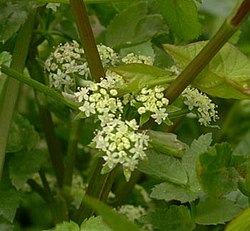| Fool's-watercress | |
|---|---|
 | |
| Scientific classification | |
| Kingdom: | Plantae |
| Clade: | Tracheophytes |
| Clade: | Angiosperms |
| Clade: | Eudicots |
| Clade: | Asterids |
| Order: | Apiales |
| Family: | Apiaceae |
| Genus: | Helosciadium |
| Species: | H. nodiflorum |
| Binomial name | |
| Helosciadium nodiflorum | |
Helosciadium nodiflorum [2] (synonym: Apium nodiflorum), fool's watercress, [1] is a flowering plant found in ditches or streams, as well as fresh and brackish-water wetlands native to western Europe. It is not poisonous to humans but it could be easily confused with the allegedly poisonous lesser water parsnip.

